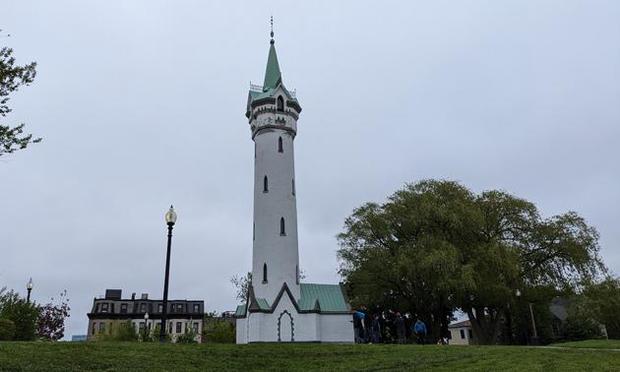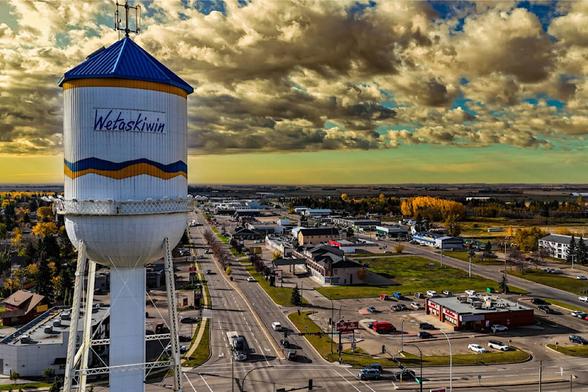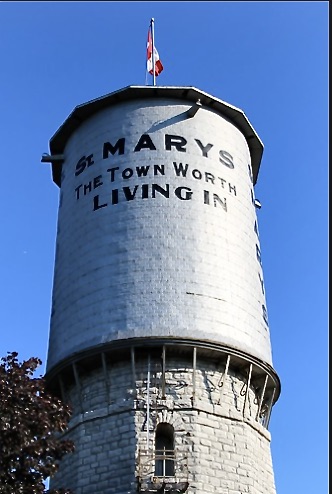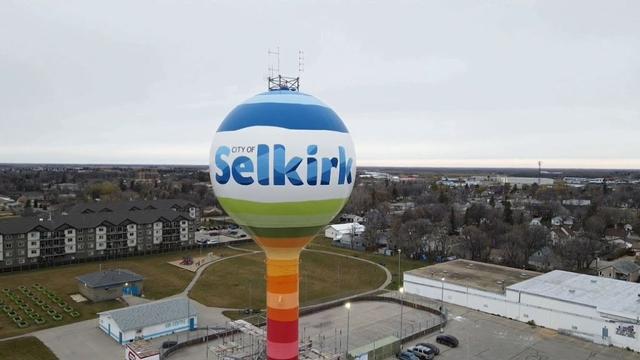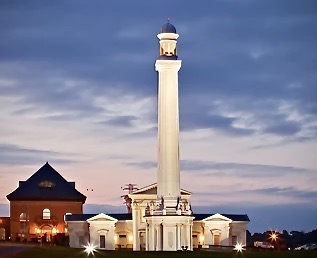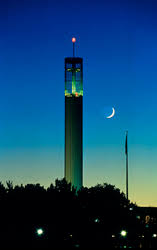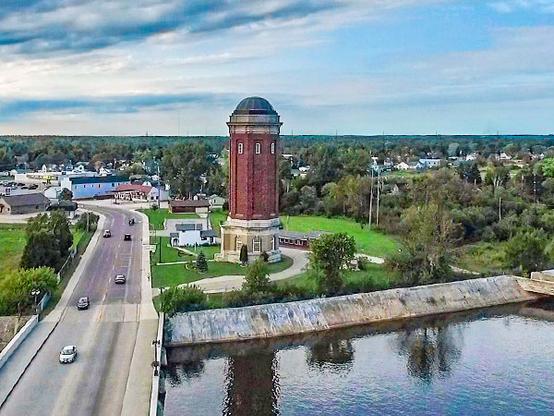Be at one with a towering presence in #Roxbury tomorrow
https://www.universalhub.com/2025/be-one-towering-presence-roxbury
#Boston #history #standpipes
#standpipes
Working lists: Canada’s tallest standpipe, spherical, and “Tin Man” style water towers
Three separate working lists are provided below for standpipe, spherical, and “Tin Man” style water towers across our beautiful neighbor to the north, Canada. The lists will be updated periodically as additional information is found. Peace!
St. Mary’s, Ontario Standpipe – Source: flickr.comSTANDPIPE
The year of completion for these standpipe water towers ranges from 1896 to 2007. The most common decades for standpipe construction (from this list) are:
- 1970s = 13
- 1980s = 7
- 1960s = 5
___
- Dorset Street Standpipe (1977): Port Hope, ON = 154 feet/47 m – to be replaced in 2027
2-4. Sombra Township Standpipe (1975): Port Lambton, ON and Aylmer Standpipe (1986): Hamilton (Aylmer), ON; and Caraquet Standpipe (1970): Caraquet, NB = 150 feet/45.7 m
5. Waterford Standpipe (1980): Waterford, ON = 142 feet/43.3 m
6. Delhi Standpipe (1978): Delhi, ON = 140 feet/42.7 m
7. North Bay Standpipe (1985): North Bay, ON = 131 feet/40 m
8. Timmons Standpipe (ca 1972): Timmons, ON = 130 feet/39.6 m
9. Ayr Standpipe (1978): Ayr, ON = 129 feet/39.3 m
10. Pointe-Claire Standpipe (1954): Pointe-Claire, QC = 125.5 feet/39.5 m
11. Waterdown Standpipe (1977): Hamilton (Waterdown), ON = 124.5 feet/38 m
12. Bouctouche Standpipe (1982): Bouctouche, NB = 120 feet/36.6 m
13. Region of Waterloo Standpipe (1982): Cambridge, ON = 113 feet/34.4 m
14. St. George Standpipe (1950): St. George, NB = 110 feet/33.5 m
15. Rockland Standpipe (1908): Victoria, BC = 109 feet/33.2 m
16. Grand Falls Standpipe (1998): Grand Falls, NL = 106 feet/32.3 m
17-19. Richmond Hill Standpipe (1980): Richmond Hill, ON; Kerrobet Standpipe (1914): Kerrobet, SK; and Mono Mills Standpipe (1978): Mono Mills, ON = 105 feet/32 m
20. Johnson Tower Standpipe (1963): White Rock, BC = 103 feet
21. Hemlock Water Storage Tank: Halifax, NS = 102 feet – added 2/19/25
22-24. Alexandria Standpipe #1 (1896): Alexandria, ON; Fenelon Falls Standpipe (1976): Fenelon Falls, ON; and Miramichi Standpipe (1977): Miramichi, NB = 100 feet/ 30.5 m
25. Woodville Standpipe (1972): Woodville, ON = 92 feet/28 m
26-27. Humboldt Standpipe (1915): Humboldt, SK and “Top of Wellington” Standpipe (1946): Clifford, ON = 95 feet/29 m
28-30. Hespeler Standpipe (1972): Cambridge, ON; Dutton Standpipe (1960s): Dutton, ON; and Moncton Standpipe (1980): Moncton, NB = 90 feet/27.5 m
31. Walkerton Standpipe #1: Walkerton, ON = 86 feet/26.2 m
32. Petrolia Standpipe (1896): Pertolia, ON = 85 feet/25.8 m
33. Waterloo Standpipe (1987): Waterloo, ON = 83 feet/25.3 m
34-36. Lacombe Home Water Tower (ca 1920): Calgary, AB; Firestone Standpipe: Calgary, AB; and Kamsack Standpipe (1915): Kamsack, SK = 80 feet/24.4 m
37. Rockwood Standpipe (2007): Rockwood, ON = 72 feet/22 m
38. Buchans Standpipe (2004): Buchans, NL = 71 feet/21.6 m
39. Bolton Standpipe (1937/1973): Bolton, ON = 69 feet/21 m
40. Walkerton Standpipe #2: Walkerton, ON = 66 feet/20.2 m
41-42. Orillia Standpipe (1967): Orillia, ON and Wabush Standpipe (1965): Wabush, NL = 65 feet/19.9 m
43. Elmvale Standpipe (1995): Elmvale, ON = 52 feet/15.9 m
44. Golf Course Standpipe (1976): Didsbury, AB = 51 feet/15.6 m
45. Kensington Standpipe: Kensington, PE = 50 feet/15.2 m
46. Labrador City Standpipe (1965): Labrador City, NL = 48 feet/14.6 m
Source: tourismsaskatchewan.comMore Information needed:
- Alliance, AB
- Andrew, AB
- Bashaw, AB
- Black Diamond, AB
- Bowden, AB
- Chipman, AB (1905)
- Clyde, AB
- Glenwood, AB
- Grand Prairie, AB x 2
- Grimshaw, AB
- High River, AB
- Irricana, AB
- Legal, AB
- Loughheed, AB
- Mundare, AB
- Rocky Mountain House, AB
- Viking, AB
- Waskatenau, AB
- Westlock, AB
- Rossland, BC
- Parksville, BC
- Victoria Standpipe #2
- Climax Standpipe, SK
- Weyburn Standpipe: Woburn, SK
- Signal Hill Arts Centre Standpipe, SK
- Norquay, SK
- Davidson, SK
- Coca-Cola Standpipe: Portage La Prairie, MB
- Maple Bay, BC
- Amhertsville, ON
- St. Mary’s ON (1899)
- Tara, ON
- Midland, ON
- Mt. Forest, ON
- Loyalist Odessa Standpipe (1978): Odessa, ON
- Kincardine, ON
- Warren, ON
- Kingston, ON x 2
- Paisley, ON
- Palmerston #2, ON
- Port Elgin, ON
- Porquois Junction, ON
- Port Perry, ON
- Powassan, ON
- Wingham, ON
- Sudbury/Walden, ON
- Renfrew Standpipe, ON
- Thamesville Standpipe, ON
- Tiverton Standpipe, ON
- Vankleek Hill, ON
- Vemer Standpipe, ON
- Alexandria, ON #2
- Vineland, ON
- Alvinston, ON
- Arkona, ON
- Azilda, ON
- Loyalist Township: Amherstview, ON
- Bancroft, ON
- Birch Island, ON
- Bradford, ON
- Brechin, ON
- Caledonia, ON
- Campbellford, ON
- Cayuga, ON
- Casselman, ON
- Cedar Springs, ON
- New Standpipe: Clifford, ON
- Colborne, ON
- Cookstown, ON
- Chatsworth, ON
- Delaware, ON
- Deseronto, ON
- Dunnville, ON
- Durham, ON
- Espanola, ON
- Finch, ON
- Forest, ON
- Halton Hills Standpipe, ON
- Glencoe, ON
- Guelph, ON x 2 (one in 2015)
- Hagersville, ON
- Hastings, ON
- Havelock, ON
- Hearst Standpipe (1977): Hearst, ON
- Lakefield, ON
- Lancaster, ON
- Lansdowne, ON
- Hockey World Standpipe: London, ON
- Madoc, ON
- Markdale, ON
- Mamora, ON
- Melbourne, ON
- Mitchell, ON
- Norwood, ON
- Orangeville, ON
- Orono, ON
- Ridgeway, ON
- Southampton, ON
- St. Catharines, ON
- Sturgeon Falls, ON
- Stoney Point, ON
- Sunderland, ON
- Walden, ON
- Warren, ON
- Watford, ON
- West Lorne, ON
- Wiarton, ON
- Wyoming, ON
- Borden-Carlton, PE
- Cornwall, PE (1995)
- Stratford, PE
- Bird Cove, NL
- Come by Chance Standpipe, NL
- Conception Bay, NL x 2
- Daniels Harbour Standpipe, NL (1992)
- Grand Bank, NL
- Ramea, NL
- Twillingate, NL
- Antogonish, NS
- Enfield, NS (1970s)
- Falmouth, NS
- Lantz, NS
- Lunenburg, NS
- Fredericton, NB x 2
- Aroostook, NB
- Perth-Andover, NB
- Riverview, NB
- Rothesay, NB
- Saint John Standpipe, NB (2003)
- St. Stephen Standpipe, NB (1988)
- Chicoutimi, QC
- Dalhousie, QC
- Lévis, QC
- Mercier, QC
- Matagami, QC (2004)
- Pierrefonds-Roxboro, QC
- Rock Forest, QC
- Shawville, QC
- Ste-Angèle-de-Laval, QC
- Ste-Anne-de-Bellevue, QC
- Sainte-Foy, QC
- Sainte-Thècle, QC (1951)
- Sainte-Julie, QC
_______
Source: myselkirk.ca Source: winnipegfreepress.comSPHERICAL
Nearly all of the water towers on this list were built in the 1960s and 1970s.
___
- Mississauga/Peel Region Water Tower (1971): Mississauga, ON = 187 feet/57 m
2-3. Thornbury Environment Water Tower: Thornbury, ON and Steinbach Water Tower (1972): Steinbach, MB = 154 feet/46.9 m
4-6. Guelph Water Tower (early 1970s): Guelph, ON; Stratford Water Tower (1964): Stratford, ON; and Brantford Water Tower = 150 feet/45.7 m – Brantford added 5/26/25
7. Selkirk Watersphere Tower (1961): Selkirk, MB = 135 feet
8. Elmira Water Tower (1964): Elmira, ON = 126 feet/38.4 m
9. Dundas Water Tower (1969): Hamilton (Dundas), ON = 121 feet/37 m
10. Horton Watersphere Tower (1969): Centralia, ON ~ 114 feet/34.8 m
11. Cambridge Water Tower (1974): Cambridge, ON = 112 feet/34.1 m
12-14. Forest Drive Water Tower (1971): Vaughan, ON; and Woodbridge Water Tower (1971): Woodbridge, ON; and Region of Waterloo Water Tower (1978): Cambridge, ON = 108 feet/33 m
15. SSM Water Tower (1969): Sault Ste. Marie, ON = 103 feet
16. Kamsack Spheroid (1978): Kamsack, SK = 88 feet/26.8 m
17. Airdrie Water Tower (1959): Airdrie, AB = 71.5 feet/21.8 m
More information needed:
- Oxbow Water Tower, SK
- Redwater, AB
- Standoff, AB
- Kelvington, SK
- Lang, SK
- Langenburg, SK
- Sturgis, SK
- Rouleau, SK
- Rose Valley, SK
- Ponteix, SK
- Coutts, AB – “Smiley”
- Killarney Water Tower, MB
- Beausejour, MB
- Ridgetown, ON
- Arthur, ON
- Peterborough, ON
- South Huron Water Tower (1974): Exeter, ON
- Wasaga Beach, ON
- Georgian Mall Water Tower (1973): Barrie ON
- Exeter, ON
- Gananoque 1000 Islands, ON
- Ingersoll, ON
- Hiram Walker Water Tower: Lakeshore, ON
- Ridgetown, ON
- St. Thomas, ON
- Wheatley, ON
- Hawkes Bay, NL
- Hubbards, NS
- Port Hawesbury, NS
- Drummondville, QC
- Rock Forest, QC
- Ste-Catherine, QC
- St-Jean-sur-Richelieu, QC
- Foam Lake, SK
_______
Source: pipestoneflyer.caTIN MAN
- St. Boniface Water Tower: Winnipeg, MB (1936) = 171 feet/52.1 m
2-3. Wetaskiwin Water Tower (1907): Wetaskiwin, AB and Gleichen Water Tower (1911): Gleichen, AB = 150 feet/45.7 m
4. Winnipeg Beach Water Tower (1928),: Winnipeg Beach, MB (1928) = 131 feet
5. Union Stock Yards Water Tower (1913): Winnipeg, MB = 80 feet/24.4 m
More information needed:
- Claresholm,, AB (1910)
- Bonnyville, AB
- Innisfall, AB
- Lethbridge, AB
- Kitscoty, AB
- Riverhead, AB
- Carmangay, AB
- Kindersley, SK
- Grand Beach, MB
- Morden, MB
- Manitou, MB
- Carman, MB
- Boissevain, MB x 2
- Brandon, MB
- Selkirk, MB
- Stoney Mountain, MB
- Tilsonburg, ON
- Tottenham, ON
- Arthur, ON (1932)
- Delhi, ON
- GSW Water Tower: Fergus, ON
- Gravenhurst, ON
- Hastings, ON
- Markdale, ON
- Mississauga, ON
- Simcoe, ON (1929)
- Sturgeon Falls, ON
- Hillsborough, NB (1931)
- Bedford, QC
- Jonquière, QC
- Montreal, QC x 3
- Schenley Water Tower: Salaberry-de-Valleyfield, QC
- Ste-Anne-de-Bellevue, QC
- St-Félicien,QC
- Sullivan, QC
- Fiske, SK
- Gravelbourg, SK
- Yorkton, SK (1930)
- Waterton, AB
- Saanich, BC
_____
SOURCES:
- https://www.waymarking.com/waymarks/WMZB0C_Lacombe_Home_Water_Tower_Calgary_AB
- https://www.waymarking.com/waymarks/WMCJ3B_Firestone_Tower_Calgary_Alberta_Canada
- http://www.eureka4you.com/watertowers/index.htm
- https://airdrielife.com/citylife/heritage-the-airdrie-water-tower/
- https://hubpages.com/travel/Visiting-the-Lethbridge-Water-Tower-Lethbridge-Alberta-fine-cuisine-and-excellen-views-of-the-Rockies-also
- https://hubpages.com/travel/Visiting-Claresholm-Alberta-Skyline-and-Historical-Landmarks
- https://www.flickr.com/photos/cmhpictures/19065037599
- https://www.waymarking.com/waymarks/WM16P33_Gleichen_Water_Tower_Gleichen_AB
- https://www.flickr.com/photos/21953562@N07/20120412462
- https://www.tourismsaskatchewan.com/listings/227/humboldt-historic-water-tower-tour
- http://www.eureka4you.com/wtower-sk-k/Kamsack1.htm
- https://live.staticflickr.com/324/19507436323_2fbf93baf4.jpg
- http://www.mhs.mb.ca/docs/sites/selkirkwatertower.shtml
- http://www.mhs.mb.ca/docs/sites/steinbachwatertower.shtml
- https://www.ctvnews.ca/winnipeg/article/how-water-towers-have-transformed-into-manitoba-skyline-icons/
- http://wikimapia.org/26342602/Winnipeg-Beach-Water-Tower
- https://bwtas.blogspot.com/2011/09/tower-hunting-in-british-columbia.html
- http://www.eureka4you.com/wtower-bc-w/WhiteRock.htm
- https://www.flickr.com/photos/68678468@N06/7152529331/
- http://eureka4you.com/wtower-on-w/Woodbridge.htm
- http://www.eureka4you.com/wtower-on-c/Cambridge4.htm
- http://www.eureka4you.com/wtower-on-m/Midland1.htm
- http://www.eureka4you.com/wtower-on-t/Thornbury.htm
- https://www.watercanada.net/work-to-start-at-odessa-ontario-water-tower/
- http://www.eureka4you.com/wtower-on-w/Waterdown.htm
- http://www.eureka4you.com/wtower-on-p/PortHope.htm
- http://www.eureka4you.com/wtower-on-p/PortLambton.htm
- http://www.eureka4you.com/wtower-on-t/Timmins.htm
- http://www.eureka4you.com/wtower-on-a/Alexandria1.htm
- http://www.eureka4you.com/wtower-on-a/Aylmer.htm
- http://www.eureka4you.com/wtower-on-a/Ayr.htm
- http://www.eureka4you.com/wtower-on-b/Bolton1.htm
- http://www.eureka4you.com/wtower-on-c/Cambridge1.htm
- http://www.eureka4you.com/wtower-on-c/Centralia1.htm
- http://www.eureka4you.com/wtower-on-c/Clifford1.htm
- http://www.eureka4you.com/wtower-on-d/Delhi1.htm
- http://www.eureka4you.com/wtower-on-d/Dundas.htm
- http://www.eureka4you.com/wtower-on-d/Dutton.htm
- http://www.eureka4you.com/wtower-on-e/Elmira1.htm
- http://www.eureka4you.com/wtower-on-e/Elmvale.htm
- http://www.eureka4you.com/wtower-on-f/FenelonFalls.htm
- http://www.eureka4you.com/wtower-on-g/Guelph1.htm
- http://www.eureka4you.com/wtower-on-h/Hearst.htm
- http://www.eureka4you.com/wtower-on-l/Lucknow.htm
- http://www.eureka4you.com/wtower-on-m/Mississauga1.htm
- http://www.eureka4you.com/wtower-on-m/MonoMills.htm
- http://www.eureka4you.com/wtower-on-n/NorthBay.htm
- http://www.eureka4you.com/wtower-on-o/Orillia1.htm
- http://www.eureka4you.com/wtower-on-r/RichmondHill.htm
- http://www.eureka4you.com/wtower-on-r/Rockwood.htm
- http://www.eureka4you.com/wtower-on-s/Stratford1.htm
- http://www.eureka4you.com/wtower-on-w/Walkerton.htm
- http://www.eureka4you.com/wtower-on-w/Waterford.htm
- http://www.eureka4you.com/wtower-on-w/Waterloo.htm
- http://www.eureka4you.com/wtower-on-w/Woodbridge.htm
- http://www.eureka4you.com/wtower-on-w/Woodville.htm
- http://www.eureka4you.com/wtower-pe-k/Kensington.htm
- http://www.eureka4you.com/wtower-nl-b/Buchans.htm
- http://www.eureka4you.com/wtower-nl-g/GrandFalls.htm
- http://www.eureka4you.com/wtower-nl-l/LabradorCity.htm
- http://www.eureka4you.com/wtower-nl-w/Wabush.htm
- http://www.eureka4you.com/wtower-nb-b/Bouctouche.htm
- http://www.eureka4you.com/wtower-nb-c/Caraquet.htm
- http://www.eureka4you.com/wtower-nb-m/Moncton.htm
- http://www.eureka4you.com/wtower-nb-m/Miramichi.htm
- http://www.eureka4you.com/wtower-nb-s/StGeorge.htm
- http://www.eureka4you.com/wtower-qc-p/PointeClaire.htm
- http://www.eureka4you.com/wtower-mb-w/Winnipeg1.htm
- http://www.eureka4you.com/wtower-sk-h/Humboldt.htm
- http://www.eureka4you.com/wtower-sk-k/Kamsack1.htm
- http://www.eureka4you.com/wtower-ab-d/Didsbury.htm
- http://www.eureka4you.com/wtower-ab-w/Wetaskiwin1.htm
- http://www.eureka4you.com/wtower-bc-v/Victoria.htm
- https://www.myporthope.ca/standpipe-replacement
- https://visitpetrolia.ca/listing/petrolia-standpipe-water-tower/
- https://westenddumplings.blogspot.com/2020/05/a-history-of-selkirks-water-tower.html
- https://www.teamlandmark.com/project/hemlock-water-storage-reservoir/
- https://www.flickr.com/photos/cmhpictures/19958502035/
- https://www.facebook.com/groups/148233285844448/
- https://www.youtube.com/shorts/OP138gMyutw
#1 #2 #Canada #cities #geography #history #planning #spherical #standpipes #stats #TinMan #tourism #towers #towns #travel #utilities #water #waterTowers
Working list: Tallest historic “standpipe” water towers in the USA
SUNY Albany Standpipe/Carillon – Source: albany.eduListed below are the tallest historic “standpipe” style water towers in the United States. For purposes of this post, historic means it was erected no later than 1980. A minimum height of 45 feet was also required for inclusion.
Louisville Water Tower (1860) – Source: shutterstock.comStandpipe water towers (or tanks) have been commonly used since the later half of the 19th century. Generally, a standpipe is a cylindrical water tank that is taller than it is wide and is not supported by legs. To improve their visual aesthetics, a number of standpipes, especially those built prior to World War II, have been constructed behind a decorative/ornamental facade of stone, brick, steel, and/or other materials. Once then, standpipes “tend” to be more utilitarian in appearance.
Manistique, MI Standpipe Water Tower (1922): Source: visitmanistique.comMany of the standpipes listed no longer function in their original water storage role and are now maintained as historic/iconic structures adorning the community. In some cases, others have been adapted into observations towers. This blog author has personally been to the top of the observation standpipes in Peoria Heights, Illinois and Cordova, Iowa (see photos below).
Peoria Heights, IL Cordova, IAAs always, any additions, corrections, or suggestions to this list are most welcome. A list of likely additional candidates is provided after this list and a partial list of post-1980 standpipes are listed afters the sources.
Peace!
Source: tamparelics.bigcartels.com_______
- SUNY Albany Standpipe/Carillon (1966): Albany, NY = 251 feet
2. Sulphur Springs Water Tower (1920s): Tampa, FL = 214 feet
3-4. Highbridge Water Tower (1872): New York City, NY and Tower Park Water Tower: Peoria Heights, IL = 200 feet
5. Mt. Washington Water Tower (1939): Cincinnati = 198 feet (to top of beacon) – added 2/14/25
6. Bissell Street Water Tower (1886): St. Louis, MO = 195 feet
7. Jones Beach Water Tower (1930): Jones Beach, NY = 188 feet – added 2/11/25
8. Louisville Water Tower (1860): Louisville, KY = 185 feet
9. Chicago Water Tower (1869): Chicago, IL = 182.5 feet
10. Compton Hill Water Tower (1899): St. Louis, MO = 179 feet
11-13. North Point Water Tower (1874): Milwaukee, WI; Weehawken Standpipe Water Tower (1883): Weehawken, NJ; and Kalamazoo State Hospital Water Tower (1895): Kalamazoo, MI = 175 feet
14. Eden Park Standpipe (1894): Cincinnati, OH = 172 feet
15. Lemmon Hill Standpipe (1888): Salisbury, MD = 165 feet
16. Tower Hill Water Tower (1896): Lawrence, MA = 157 feet
17-18. Belton Standpipe (1909 or 1914): Belton, SC and Millwood Standpipe (1969): Millwood, WA = 155 feet
19. Grand Avenue Water Tower (1871): St. Louis, MO = 154 feet
20. Lawson Water Tower (1902): Scituate, MA = 153 feet
21. Roland Park Standpipe (1905): Baltimore, MD = 148 feet
22. Ypsilanti Water Standpipe (1890): Ypsilanti, MI = 147 feet
23. Brainerd Water Tower (1920): Brainerd, MN = 141 feet
24. Manistique Water Tower (1922): Manistique, MI = 137.5 feet
25-26. Waldo Water Tower (1920): Kansas City, MO and South Hill Water Tower (1931): Spokane, WA = 134 feet
27. Walterboro Standpipe (1915): Walterboro, SC = 133 feet *Base was originally used as a jail.
28-29. Harper Standpipe Water Tower (1887): Harper, KS and Pipestone Standpipe (1920): Pipestone, MN = 132 feet
30-31. Cochituate Standpipe at Fort Hill (1869): Roxbury, MA and Wilmette Standpipe (1956): Wilmette, IL = 130 feet
32. Highland Park Water Tower (1928): St. Paul, MN = 127 feet
33. Chestnut Hill Standpipe (1859): Philadelphia, PA = 125 feet
34. Lena Water Tower (1896): Lena, IL = 122.5 feet
35. Fall River Standpipe (1875): Fall River, MA = 121 feet
36-37. Telegraph Hill Water Tower (1903), Hull, MA and Accokeek Standpipe (1973): Largo, MD = 120 feet
38. Caruthersville Water Tower (1903): Caruthersville, MO = 115 feet
39-40. Fort Atkinson Water Tower (1901): Fort Atkinson, WI and The Water Tower Standpipe (1892): Western Springs, IL = 112 feet – Western Springs added 2/9/25
41. Florence Standpipe Water Tower (1887): Florence, KS = 110 feet
42-47. Monticello Standpipe (1895): Monticello, IN; Prospect Park Water Tower (1914): Minneapolis, MN; Washburn Standpipe: Minneapolis, MN (1931); Addison Standpipe (1953): Addison, MI – may be replaced; and Akron Standpipe: Akron, PA – may be replaced; and Troy Standpipe (1943): Troy, AL = 110 feet
48-49 Bradley Hills Standpipe 1 (1939): Bethesda, MD and Bradley Hills Standpipe 2 (1961): Bethesda, MD ~ 107 feet
50-52. Seminole Standpipe (1972): Seminole, FL; Cordova Standpipe Observation Tower: Cordova, IA; and USM Standpipe (1950s): Oak Bluff, ME = 105 feet
53-54. Remington Water Tower (1897): Remington, IN and Bremen Waterworks Standpipe (1892); Bremen, IN = 104 feet
55. San Carlos Pump Station Standpipe (1967): San Diego, CA = 102 feet
56. North Park Water Tower (1937): Pittsburgh, PA = 101 feet
57-62. Baton Rouge Standpipe (1888): Baton Rouge, LA; Fresno Water Tower (1894): Fresno, CA; Water Works Standpipe (1897): Dothan, AL; Sun Prairie Water Tower (1899): Sun Prairie, WI; Lineville Standpipe Water Tower (1917): Lineville, AL; and Hinsdale Standpipe (1956): Hinsdale, IL = 100 feet – Fresno added 2/9/25
63. Leaning Tower of Niles (1934): Niles, IL = 94 feet – added 2/9/25
64-68. Elyria Waterworks Tower (1879): Elyria, OH = 90 feetColorado City Standpipe (1884): Colorado City, TX; Lake City Water Standpipe (1893): Lake City, IA; Riverside Standpipe (1913): Riverside, IL; and El Conquistador Water Tower (1928): Tucson, AZ = 90 feet – added El Conquistador on 2/9/25
69-71. Havana Water Tower (1889): Havana, IL; Kasson Water Tower (ca 1895): Kasson, MN; and Abbotsford Standpipe (1903): Abbotsford, WI = 86 feet – Abbotsford added 2/16/25
72. Dunster Road Standpipe (1950): Needham, MA = 85 feet
73. Ogilvie Water Tower (1918): Ogilvie, MN = 82 feet
74-77. Monroe Water Tower (1889): Monroe, WI; Fort Ethan Allen Standpipe (1893), Essex, VT; Evansville Standpipe (1901): Evansville, WI; and Arlington Reservoir Standpipe (1924): Arlington, MA = 80 feet
78. 14th Avenue/Volunteer Park Standpipe (1906): Seattle, WA = 76 feet
79-80. Belton Standpipe (1911): Belton, TX = 75 feet and Red Wing Tower (1921) ~ 75 feet – added 2/11/25
81. Gaunt Park South Standpipe (1978): Yellow Springs, PH = 73 feet
82. Benton Stone Water Tower (1900): Benton, WI = 67 feet
83. Forbes Hill Standpipe (1900): Quincy, MA = 64 feet
84-85. Greenbelt Standpipe (1936): Greenbelt, MD and Gaunt Park North Standpipe (1962): Yellow Springs, OH = 63 feet
86. Thornden Park Standpipe Water Tower (1894): Syracuse, NY = 60 feet
87. Old Clinton Water Tower (1895): Clinton, WI = 59 feet
88-89. Thomas Hill Standpipe (1897): Bangor, ME and Landmark Standpipe (1922): Manhattan, KS = 50 feet
90. Dell Rapids Water Tower (1894): Dell Rapids, SD = 45 feet
Fall River Standpipe – Source: herald news.comAdditional standpipes needing more information:
- Allendale Standpipe (1915): Allendale, SC
- Collyer Standpipe (1931): Collyer, KS
- Standpipe Water Tower (1890): Tallapoosa, GA
- Old Water Tower (1923): Gordon, GA
- Holton Standpipe (1940s): Holton, ID
- Bushong Standpipe: Bushong, KS
- Woods of Tama Standpipe: Poolesville, MD
- Arthur Boniface Water Tower (1929): Scarsdale, NY
- Suez Spring Valley Standpipe: Spring Valley, NY
- Huntington Reservoir Water Tower (ca 1885): Bay Village, OH
- Wayne Standpipe: Wayne, OK
- Vernon Tanks (1906 and 1914): Portland, OR
- Floral Standpipe: Troutdale, OR
- Old Town Clock Water Tower (1871/2): Rome, GA – added 2/9/25
- Selinsgrove Standpipes (3), PA
- Agnews State Hospital/Levee Road Standpipe: Santa Clara, CA – added 2/9/25
- Melville Park Standpipe: Portsmouth, RI
- Earls’s Court Water Tower: Narragansett RI
- Missionary Ridge Standpipe (1924): Chattanooga, TN
- McKenna Park Standpipe (1957): Denton, TX
- Minco Standpipe, OK
- Mystic Islands Standpipe: Little Egg Harbor, NJ
- Stucile Water Tower (ca 1930): Ocean Township, NJ
SOURCES:
- https://en.wikipedia.org/wiki/Bremen_Water_Tower
- http://www.waterworkshistory.us/tech/standpipes.htm
- https://en.wikipedia.org/wiki/Thomas_Hill_Standpipe
- https://www.scpictureproject.org/allendale-county/allendale-standpipe.html
- https://www.scpictureproject.org/anderson-county/standpipe-water-tower.html
- https://www.kwtx.com/content/news/Belton-Standpipe-water-tower-becomes-local-historic-landmark-559876171.html
- https://www.facebook.com/cityofharper/posts/historical-standpipe-water-tower-renovation-complete-harpers-historic-standpipe-/1031081950668146/
- https://www.cbsnews.com/minnesota/news/the-awe-inspiring-minneapolis-water-tower-protected-by-8-ton-stone-guardians/
- https://www.atlasobscura.com/places/washburn-park-water-tower
- https://www.allendalecounty.com/visitors/allendale_standpipe.php
- https://www.strangecarolinas.com/2020/02/water-tower-jail-walterboro-sc.html
- https://www.snyder-associates.com/community-water-storage-solutions-how-to-select-a-water-tank/
- https://en.wikipedia.org/wiki/Ypsilanti_Water_Tower
- https://tataandhoward.com/tag/standpipes/
- https://en.wikipedia.org/wiki/Water_Works_Standpipe_(Dothan,_Alabama)
- https://www.hmdb.org/m.asp?m=115022
- https://www.waymarking.com/waymarks/WMH7AW_Troy_Municipal_Standpipe_Troy_AL
- gemini.google.ai
- https://www.hmdb.org/m.asp?m=119817
- https://pttg.com/blogs/historic-water-towers.php
- https://en.wikipedia.org/wiki/Havana_Water_Tower
- https://en.wikipedia.org/wiki/Lena_Water_Tower
- https://en.wikipedia.org/wiki/Fall_River_Waterworks
- https://en.wikipedia.org/wiki/High_Service_Water_Tower_and_Reservoir
- https://en.wikipedia.org/wiki/Arlington_Reservoir,_Massachusetts
- https://www.hmdb.org/m.asp?m=50842
- https://en.wikipedia.org/wiki/Kalamazoo_State_Hospital_Water_Tower
- https://en.wikipedia.org/wiki/Brainerd_Water_Tower
- https://fertfaust.wixsite.com/brainerd-history/water-tower
- https://cms4files.revize.com/dodgecountymn/Play/Kasson%20Water%20Tower.pdf
- https://en.wikipedia.org/wiki/Prospect_Park_Water_Tower
- https://en.wikipedia.org/wiki/Ogilvie_Watertower
- https://en.wikipedia.org/wiki/Waldo_Water_Tower_(Kansas_City,_Missouri)
- https://en.wikipedia.org/wiki/Caruthersville_Water_Tower
- http://www.waterworkshistory.us/OH/Elyria/
- https://en.wikipedia.org/wiki/Dell_Rapids_Water_Tower
- https://theclio.com/entry/142721
- https://en.wikipedia.org/wiki/Monroe_Water_Tower
- https://www.wisconsinhistory.org/Records/NationalRegister/NR2067
- https://en.wikipedia.org/wiki/Sun_Prairie_Water_Tower
- https://en.wikipedia.org/wiki/Fort_Atkinson_Water_Tower
- https://www.hmdb.org/m.asp?m=133537
- https://en.wikipedia.org/wiki/Evansville_Standpipe
- https://en.wikipedia.org/wiki/Eden_Park_Stand_Pipe
- https://mycentralnewyork.blogspot.com/2017/07/syracuse-high-points-2-thornden-park.html
- https://en.wikipedia.org/wiki/Lake_City_Water_Standpipe
- https://www.waymarking.com/waymarks/wm4ZXK_Seminole_County_Standpipe
- https://en.wikipedia.org/wiki/Forbes_Hill_Standpipe
- https://sites.google.com/site/tallapoosaga/local-history/history-of-tallapoosa/standpipe-water-tower
- https://vanishinggeorgia.com/2017/11/12/old-water-tower-1923-gordon/
- https://cms4files.revize.com/hinsdaleil/Public%20Services/Press%20Releases/Hinsdale%20Constuction%20Project%20-%20Standpipe%20Rehab%202023.pdf
- https://www.riverside.il.us/421/Riverside-Water-Tower
- https://www.wilmette.gov/316/Water-Management
- https://www.holtonrecorder.net/news/citys-old-water-tower-continues-be-asset
- https://web.seattle.gov/DPD/HistoricalSite/QueryResult.aspx?ID=1206048203
- https://commons.wikimedia.org/wiki/File:Standpipe_water_tower_Addison_MI_2023.jpg
- https://www.spokesman.com/stories/2012/aug/16/south-hills-art-deco-style-tower-unique/
- https://www.monticelloin.gov/document-library/water-works-department/189-water-department-history/file
- https://calhounburns.com/project/marion-county-cordova-observation-tower/
- https://khri.kansasgis.org/photos_docs/161-2766_13.pdf
- https://www.wwdmag.com/wastewater-treatment/article/10916994/long-term-settlement-of-a-large-water-standpipe
- https://apps.mht.maryland.gov/medusa/PDF/BaltimoreCity/B-52.pdf#:~:text=Baltimore.%20Baltimore%20West%20Quad.%20The%20Roland%20Park,a%20large%20stand%20pipe%20that%20supplied%20water
- https://www.poolesvillemd.gov/271/Water-Sewer#:~:text=How%20does%20our%20water%20system%20work?&text=The%20system%20consists%20of%20about,from%20each%20of%20the%20wells.
- https://www.wsscwater.com/sites/default/files/2024-03/Bradley%20Hills%20Standpipe%20Power%20Point%20Final.pdf
- https://www.greenbeltnewsreview.com/news-stories/water-tower-rehabilitation-set-to-begin-by-next-summer/
- https://www.needhamma.gov/293/Water-Distribution-System
- https://www.manistique.org/oldtower.html
- https://en.wikipedia.org/wiki/Pipestone_Water_Tower
- https://www.scarsdale.gov/180/Arthur-Boniface-Water-Tower
- https://ysnews.com/news/2023/07/yellow-springs-water-towers-to-be-rehabbed-painted
- https://kktarchitects.com/projects/osu-tulsa-gateway-tower/
- https://www.swoknews.com/water-tower-50-000-grant-received-from-the-oklahoma-water-resources-board-will-offset-the/article_15bdf590-c98e-51ba-8b1e-3d0d59667c2f.html
- https://blaine.okcounties.org/file/bids/20180523141418917_192.pdf
- https://alamedahistory.org/2020/04/22/vernon-tanks-landmarks-hidden-in-plain-sight/
- https://www.thirdstopontheright.com/north-park-water-tower/
- https://www.wtrec.org/about
- https://www.workshopoftheworld.com/chestnut_hill/water_tower.html
- https://lancasteronline.com/news/regional/akron-borough-council-mulls-over-fate-of-aging-standpipe/article_c6946abe-6705-11ef-a65a-eb0914ceaf91.html
- https://redhookny.gov/DocumentCenter/View/3667/Red-Hook-Water-Tank-Engineering-Report
- https://www.richmondri.com/DocumentCenter/View/2593/Water-Tank-Cleaning-and-Inspection-091823?bidId=
- https://www.goxplr.com/places/melville-park-stand-pipe/
- https://www.wildthingsgardendesign.com/blog/earlss-court-water-tower-in-narragansett-rhode-island
- https://www.auburn-reporter.com/news/muckleshoots-colorful-standpipe-named-tnemec-tank-of-the-year-runner-up/
- file:///Users/ricknkathy/Downloads/Lafayette_City_Council_EBMUD_1-9-23_Lafayette_Tower_Final_Presentation_006%20(1).pdf
- https://www.sandiegoreader.com/news/2013/mar/01/stringers-san-carlos-pump-station-slated-/
- https://www.delmarvanow.com/story/news/local/maryland/2017/08/04/salisbury-landmark-old-standpipe/537921001/
- https://stispfa.org/award/sunset-mesa-tank-fisher-tank-company/
- http://www.millwoodhistory.com/water-tower.html
- https://www.albany.edu/news/release_4546.shtml
- https://lumiflonusa.com/case-studies/water-tanksinfrastructure/university-at-albany-standpipe-features-advanced-fluoropolymer-coating-system/
- https://tataandhoward.com/service/storage/page/2/
- https://eber.se/arkiv/torn/us/il.htm#western-springs
- https://www.tucsonaz.gov/files/sharedassets/public/v/1/city-services/planning-development-services/historic-preservation/documents/il_elconquistadorwatertower.pdf
- https://www.vniles.com/883/Leaning-Tower-of-Niles
- https://eber.se/arkiv/torn/us/ca.htm#fresno
- https://www.longisland.com/news/12-03-19/crazy-facts-about-the-jones-beach-water-tower.html#google_vignette
- https://www.mprnews.org/story/2010/06/02/mntoday-sounds-anderson-center
- https://www.centralwinews.com/tribunephonograph/2020/07/14/abby-water-tower-needs-refurbishing/?destination=tribune-phonograph
- https://www.timesfreepress.com/news/2018/jan/26/missionary-ridge-tank-repainted/
Other tall newer standpipes:
- Okeene Standpipe (ca 2018): Okeene, OK = 135 feet
- Sunset Mesa Standpipe (2022): Montrose, CO = 125.5 feet
- Muckleshoot Indian Tribe Standpipe (1995): Newaukum, WA = 120 feet
- Magnolia Standpipe (ca 2010): Magnolia, IA = 110 feet
- Chattanooga Standpipe (1991): Chattanooga, OK = 100 feet
- Red Hook Standpipe (1989): Red Hook, NY = 98.5 feet
- Richmond Standpipe (1987): Richmond, RI = 80 feet
- Tulsa OSU Gateway Tower: Tulsa, OK = 70 feet
- La Grande Water Tank (2008): San Francisco, CA
#architecture #art #cities #design #engineering #environment #geography #history #landUse #planning #standpipes #travel #water #waterTowers
Standing tall: Celebrating the adaptive reuse of our water towers
All too often across the United States, when a building or structure becomes old, despite its history and/or iconic appearance, it is till torn down when its ages beyond its intended lifespan or deemed usefulness. This applies to both structures in the public and private realm and far too frequently is due to expediency or just plain dollars and cents.
Source: letstalkscience.caOne type of structure that too often bites the dust, instead being preserved, are water towers. Often, the single most visible amenity in the community due to their height (and design), water towers provide a critical service, particularly for supplying drinking water, maintaining water pressure, and for fire-fighting purposes.
Through the years, the trend has been to increase the storage capacity and/or height of individual water towers and their numbers as places grow in population. This has left many aging water towers of various shapes and sizes left behind as a charming relic of a former era or possibly fulfilling a minor role related to its original purposes. The most unfortunate situation arises when older water towers are simply felled to the ground like a mighty tree or are being carved up into pieces and sold for scrap.
Beautiful old “Tin Man” style water tower in Groveport, Ohio being decapitated in 2015 – Source: columbusmessenger.com A felled water tower awaits its fate next to its replacement in Sweetwater, Texas – Source: ktxs.comFortunately, there are a number of places around the country who have discovered unique and re-useful purposes for their aging water towers. This post is dedicated to celebrating and championing the success of those often grassroots efforts by these communities and local citizenry in protecting these wonderful landmarks.
Source: facebook.com/cannerydistrictHere are examples of possible adaptive reuses for water towers (or tanks) identified to date:
- Convert the tower into a piece of art (static or interactive)
- Community gathering place
- Community branding/focal point
- Observation tower
- Historic site or landmark
- Residential dwelling(s) – more common in Europe
- Library
- Elevated location for wireless and communications antenna – this author’s least favorite reuse option
_______
WATER TOWER INTO A WORK OF ART – MULTIPLE EXAMPLES
Many of us take functional items like water towers for granted. Just another piece of infrastructure we pass by on a regular basis. Despite the unique architectural attributes and flair associated with each generation of water towers, seeing them as a work of art may be a stretch for some. But, there is beauty in functionality. Andy Warhol was famous for making art out of the mundane…the common…the functional. So why not a water tower? or even a shorter water tank?
Well, Las Cruces, New Mexico; Brooklyn, New York, and Yelm, Washington all present fine examples of turning water towers into an art form. For Las Cruces, it’s water tanks have become iconic murals. In Brooklyn, a stained-glass rooftop masterpiece. While in Yelm, Washington…an evolving light show.
Beautiful water tank mural in Las Cruces, New Mexico – Source: lcnews-sun.comAnother mural water tank in Las Cruxes, New Mexico – Source: lascrucesbulletin.com“The 32-foot tall water tanks could easily be eyesores that disrupt otherwise panoramic views of the southern New Mexico town. But in Las Cruces, local artists have turned the curved canvasses into works of art. Using a color palette inspired by Mother Nature to share the rich history of the area, the water tank murals share the stories of the Native Americans who originated in the area and the settlers who followed.”
Source: everdaywanderer.com
As seen in Las Cruces, water towers (or tanks) can become a living embodiment of the community’s combined personality–reflecting the history, pride, culture, and overall sense of the specific place they exist. It may not be hung on a wall in an art museum, but an iconic water tower (or tank) can be the perfect canvas from which to work, while definitely making its presence known and standing out from the crowd much like a fine work of art.
Stained-glass water tower in the Dumbo Neighborhood of Brooklyn – Photo source: reddit.comOne of the most beautiful water towers in the nation isn’t even a real water tower, but a rooftop work of art on a building in the Dumbo Neighborhood of Brooklyn, New York. The artist who created this magnificent stain-glassed work certainly found the simple water tower to indeed be a work of art!
And when a water tower is paired with active or static lighting, their personality really does begin to shine. Yelm, Washington has successful done this with its historic “Tin Man” styled water tower.
Yelm’s historic water tower lights up the night with the local high school’s team colors – Source: yelmonline.com“Through two new projects funded by the Washington State Legislature, the City of Yelm is simultaneously preserving the past while looking to the future. The iconic 125-foot water tower that has loomed over the town since the 1940s is being converted into an art piece, while a new building, to be constructed almost directly under the tower will house a satellite branch of South Puget Sound Community College and a business incubator space.”
Source: thurstontalk.com
_______
WATER TOWER TO A GATHERING PLACE – GILBERT, ARIZONA
While certainly not the only example, Gilbert, Arizona has gone above and beyond in making its historic “Tin Man” style water tower into a gathering place within the city. Similar to being a branding/focal point of the community as discussed below, an historic/iconic water tower gives instant credibility to a third place with its size and panache often being the hallmark of the site. Just refer to the earlier photo of the water tower in Bozeman, Montana’s Cannery District earlier in this post for a perfect example.
Source: discovergilbert.comhttps://www.instagram.com/gilbertyourtown/reel/Cz4p-UiPoZh/
Furthermore, at last two cities hold annual Water Tower Festivals – Pipestone, Minnesota and Hernando, Mississippi. In 2025, Pipestone will be holding its 36th annual event and in Hernando this year will be the 51st festival.
Source: hernandoms.org_______
WATER TOWER FOR BRANDING/FOCAL POINT – MULTIPLE EXAMPLES
Utilizing a water tower for branding your community is pretty much a no-brainer use of an existing water tower and reuse of an historic/iconic one. Often, the historic/iconic water towers are located close to downtown, in historic districts, or is located in an activity-centered location the community would like to promote (see the gathering place examples above). This makes reuse of the historic/iconic water a win-win situation, as it can be both a giant elevated promotional sign and also a focal point for the attraction(s). Two excellent examples are provided below from Santa Ana, California and Dallas, Texas.
In the Dallas case, as with some others around the country, the wording added to the water tower can help promote a cause or event that is important to the community.
Many more examples of such reuse efforts can be found from across the country.
Santa Ana, California brands itself as “Downtown Orange County on its iconic water tower – Source: instagram.com/cityofsantaana “Creating Harmony” themed water tower in Dallas’ Deep Vellum neighborhood – Source: obeygiant.com_______
WATER TOWER TO AN OBSERVATION TOWER – MULTIPLE EXAMPLES
Converting an existing water tower can be an option for communities to preserve iconic structures. In some cases, such as the Giant City State Park and Peoria Heights Water Towers, both in Illinois, the observation infrastructure were built into the structure from the start. The Peoria Heights tower even has a quaint built-in ticket booth at the base of the tower.
Peoria Height Water/Observation Tower – Photo by author: 2021Ticket booth at the base of the Peoria Heights Water Tower – Source: martin-wombacher.squarespace.comIn other cases, the water tower is opened up a few times a year for visitors to see the interior and climb to the top (e.g. Highland Park Water Tower in St. Paul – see photo below).
And then there are cases ware an historic water tower is refurbished/reused as an observation tower, as is taking place in North Park just outside of Pittsburgh. All are excellent ways to adapt an existing structure (when it still contains water for not) for and alternative and useful purpose.
Giant City State Park Water/Observation Tower, Illinois – Source: pinterest.com/brandigivens Highland Park Water/Observation Tower – St. Paul, Minnesota – Source: historictwincities.com North Park Water/Observation Tower – Pittsburgh, Pennsylvania – Source: uncoveringpa.com_______
WATER TOWER AS AN HISTORIC SITE – MULTIPLE EXAMPLES
Provided a water tower survives many years of use, care, and potential neglect without being removed or felled in favor of a newer or larger structure, it can become eligible for inclusion on the National Register of Historic Places, as well as local and state historic lists. As a largely ceremonial designation, this honor does not necessarily provide water towers with guaranteed protection from being replaced or torn down.
Meanwhile, there are many historic/iconic water towers that have been and are protected because of their architectural significance or importance to local/regional/state or national history. Here are just a few of them in the United States.
- Chicago Water Tower (1869) – this handsome Gothic Revival architectural water standpipe survived the Great Chicago Fire of 1871.
- Fall River Waterworks Standpipe Water Tower (ca 1870s), Massachusetts
- Fremont, Elkhorn and Missouri Valley Railroad Water Tower: Lusk, Wyoming (1919)
- Louisville Water Tower (1860) – the world’s oldest ornamental water tower.
- Remington Water Tower (1897), Indiana
WATER TOWER TO A RESIDENTIAL DWELLING – SEAL (SUNSET) BEACH, CALIFORNIA
The option of converting an older water tower to a residential dwelling (or dwellings) would be considered unique and very site-specific based on a variety of factors from condition of the water tower, to its location to local zoning/building codes, to community acceptanc and other factors. Obviously, a water tower house is not for everyone. But, in case of the Seal (Sunset) Beach, California home shown below, not only is is an historic attraction that offers tours, but the dwelling can be rented.
Source: sunsetbeachwatertower.com_______
WATER TOWER TO A LIBRARY – TOA BAJA, PUERTO RICO
Probably the most unique reuse of a water tower anywhere in the nation is the old Levittown Water Tower in Toa Baja, Puerto Rico. Beneath the superstructure of the tower, the city built its library and incorporated aspects of the tower into the building.
Perhaps, more utility departments should consider locating their offices in a similar manner? Another option might be to locate a locate historical society offices below the tower? Despite my criticism of the digital gadgets located on the water tower in Los Lunas, New Mexico (see below), the city’s historical society museum is located directly adjacent and the off-street parking is around the base of the tower.
The point is–thinking outside the box (literally), can help save historic/iconic water towers!
_______
OLDER WATER TOWER FOR WIRELESS/COMMUNICATIONS ANTENNA – COMMON
The reason I dislike this option is because the communications antenna and equipment detract from the historic/iconic integrity and appearance of the water tower. Though…if the equipment helps to preserve an older water tower that would otherwise be destroyed, then such an option becomes a necessary evil to save the tower.
A water tower in Los Lunas, New Mexico where too much digital gadgetry detracts from the historic integrity the water tower – Photo by author: 2025Preferably, the antenna and equipment are designed in such a manner that the blend in or are camouflaged to limit their intrusion into the original design and appearance of the water tower. Otherwise, the water tower begins to look like an elevated pin cushion.
_______
As is clearly evident throughout this post, the protection and preservation of historic/iconic water towers can be and has been successfully accomplished across the country. Water towers (and tanks) come in all sorts of shapes and sizes, are constructed of a variety of materials, and are designed in numerous forms and styles. Whether they be a standpipe, a “Tin Man,” a spheroid, or just a low-rise tank; water towers (and tanks) often become symbolic of their community. As such, they play an important role in the history, culture, and dynamics that shape each place. If for no other reason, this is factor alone is why they should be preserved and protected whenever possible.
Source: cdn.shopify.comHopefully, this post will enlighten those across the country who ultimately decide the fate of these iconic structures, while also embolden those who are fighting for the preservation and protection of these landmark water towers in their community. As but one example of establishing and maintaining the context of “place,” historic/iconic water towers are perhaps the most recognizable and identifiable aspect of a community. Let’s work together to make sure their important role is not forgotten with time and is celebrated in a manner that enhances both the water tower and overall sense of “community.” Peace!
Belen, New Mexico formally designated its beautiful “Tin Man” style water tower an Historic Landmark in 2020 – Source: Photo by author: 2025SOURCES:
- https://recyclenation.com/2011/03/water-towers-recycle-houses/
- personal knowledge and observations
- https://sunsetbeachwatertower.com/
- https://www.columbusmessenger.com/old-groveport-water-tower-taken-down.html
- https://ktxs.com/news/local/video-sweetwater-water-tower-demolished
- https://www.instagram.com/cityofsantaana/p/CdEJuhthv3h/
- https://www.discovergilbert.com/soundbites/
- https://www.facebook.com/cannerydistrict
- https://www.thurstontalk.com/2019/07/30/yelm-preserves-the-past-while-looking-to-the-future/
- https://obeygiant.com/cultivate-harmony-water-tower-mural-in-deep-ellum/
- https://yelmonline.com/stories/yelms-historic-water-tower-lights-up-the-night-sky,277804
- https://www.pinterest.com/pin/763712049330521675/
- http://www.historictwincities.com/2019/04/03/highland-park-water-tower/
- https://uncoveringpa.com/north-park-water-tower
- https://martin-wombacher.squarespace.com/blog/2014/10/23/shivering-heightsa-trip-to-tower-park-in-where-else-the-heights
- https://everydaywanderer.com/las-cruces-water-tank-murals
- https://www.lcsun-news.com/story/life/sunlife/2016/09/11/artist-week-tony-pennock/89771150/
- https://www.lascrucesbulletin.com/stories/artist-tony-pennock-water-tank-murals-and-much-more,5868
- https://www.tomfruin.com/watertower.html
- https://www.architecture.org/online-resources/buildings-of-chicago/chicago-water-tower
- https://pttg.com/blogs/historic-water-towers.php
- https://www.indianalandmarks.org/2018/07/historic-water-towers-withstand-the-pressure-of-time/
- https://www.heraldnews.com/story/news/2024/04/24/fall-river-19th-century-water-dept-buildings-open-to-public-for-tours/73420418007/
- https://www.news-bulletin.com/news/belen-water-tower-designated-as-historic-landmark/article_fbf3423e-a703-58e0-b8a3-69a8daa78cb3.html
- https://www.hernandoms.org/watertowerfestival
- https://business.pipestoneminnesota.com/events/details/water-tower-festival-2025-2391
#adaptiveReuse #art #brandding #cities #community #culture #design #dwellings #festivals #fun #historic #historicSites #history #iconic #infrastructure #landUse #landmark #libraries #placemaking #places #planning #preservation #protection #signs #standpipes #tanks #TinMan #tourism #travel #water
